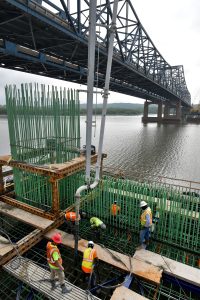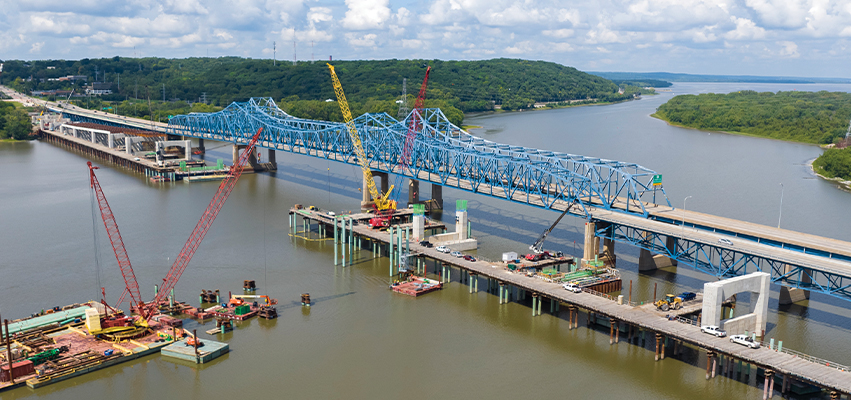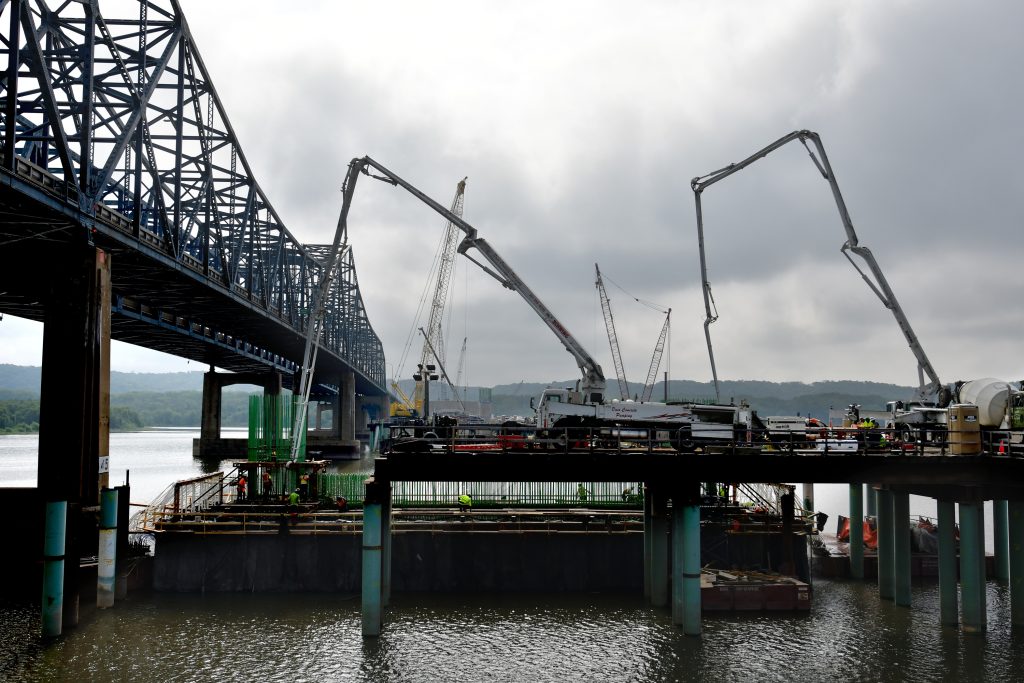In pushing ahead with the mammoth McClugage Bridge project, the contractor had to keep his cool.
With concrete, that is.
The heat of concrete, more than 75,000 cubic yards of it in total, has been one of just a handful of challenges in the $167 million effort to replace the McClugage’s current eastbound span.
Nonetheless, now in its third year, “the project is progressing well,” said Paul Wappel, spokesman for the Illinois Department of Transportation, which is overseeing the project. By shortly after Labor Day, 17 of the 27 piers and abutments were complete.
The only delay involved 36 days lost because of flooding in 2020, Wappel said. The new lanes should open for traffic in late fall, 2023, with the entire project – including demolition of the current eastbound bridge – wrapping up in December 2024.

But to keep things humming, the primary contractor — Johnson Brothers Corporation of Grapevine, Texas – has had to push past several potential roadblocks. Perhaps the trickiest has been the pouring of concrete in the support structure.
“With the thickness of some of the concrete pours – up to 14 feet thick — the heat given off by the concrete as it sets must be controlled,” Wappel said. “The contractor had to devise a plan to cool the concrete while it is curing.
“They are doing this by pumping river water through plastic tubes embedded in the concrete and monitoring the temperatures with sensors that are also embedded. Once the concrete has sufficiently cooled, the tubes are pumped full of grout.”
Otherwise, there were two other challenges:
- Access: To get closer to the construction area, workers built a temporary trestle, which is visible to passing motorists.
“It is made up of steel-pipe piling and beams that support wooded mats 12 inches thick,” Wappel said. “The trestle is designed to hold loads in each of its 45-foot spans up to 350,000 pounds.”
- The arch segment: At midpoint, the new span will be supported by an arch tied by cables to the deck. The configuration, known as deck-tied arch, is akin to the design of the Abraham Lincoln Memorial Bridge carrying Interstate 39 over the Illinois River at LaSalle.
“The assembly of the arch span is a complicated task that is being worked through currently,” Wappel said. “The contractor is building a temporary area of falsework” – a temporary framework
– “just south of the bridge. This is where they will assemble the entire arch span minus the deck, lift the 652-feet span, float it to Piers 12 and 13, and rest it down on the bearings atop these two piers.”
That new bridge layout will be different than the through-truss design used on both the westbound and eastbound spans. Through-truss was a common bridge design through the 1960s, when the cost of steel was much lower. These days, though, the design is rarely used.
The current eastbound bridge was constructed in 1948 as a two-laner – one east, one west — to replace the decrepit Upper Free Bridge. The planning had actually begun nine years earlier, during the Great Depression and before America’s entry into World War II, which delayed the construction. Once completed, the original structure – just 29 feet across — was designed to handle 5,000 to 6,000 vehicles a day.
As central lllinois’ population grew, so did the traffic, of course. In 1982, a larger bridge was built just to the north to accommodate westbound traffic, with the original span converted to eastbound-only traffic.
Together, the two spans are known as the McClugage Bridge, named in honor of David H. McClugage, Peoria’s mayor from 1937 to 1941. The original was rehabilitated multiple times over the last seven decades before IDOT concluded that it had reached the end of its safe and useful life, hence this latest investment.
In 2014, IDOT began drawing up plans for the original bridge’s replacement, with the project put out for bid in 2019. The funding is split 80-20 between federal and state dollars.
Beyond structural security, the new bridge will increase capacity with three 12-foot-wide traffic lanes, thereby relieving congestion. Additionally, it will have two 10-foot shoulders, which will enhance safety. Finally, it will include a 14-foot-wide, protected recreational path for pedestrians and cyclists. A belvedere, or lookout, will extrude from the multi-use lane, allowing visitors to step out over the river.
Together, the two bridges can handle more than 40,000 vehicles per day.
After traffic begins flowing eastbound on the new span in 2023, the project will still be a year out from completion, with work continuing on the bridge’s connection to Adams Street. Plus, small parks and parking lots will be built on each side of the bridge.
Finally, the curious will have their eyes glued on the original eastbound span as it vanishes into history. At least part of it will go with a bang, not a whimper.
“The contractor has not yet submitted an official plan,” Wappel said. “However, they have indicated that it will likely be a combination of demolition through the use of explosives and dismantling. The main span of the existing bridge that sits above the navigation channel is what would likely be demolished with explosives, with the remainder of the bridge being dismantled.”
When the project is done, IDOT will then turn its attention to the westbound span. As part of a separate, $54 million project, the bridge will undergo painting and partial replacement, including a new deck. The project also includes work on the Toledo, Peoria & Western Railway bridge.
Mcclugage Bridge Project:
Vital Stats
- Bridge length: 4,698.5 feet
- Cost: $167 million
- Primary contractor: Johnson Brothers Corporation, Grapevine, Texas
- Number of workers: 90 to 110 tradespeople per day, plus 20 managers from the primary contractor and the Illinois Department of Transportation
- Amount of steel: 20 tons
- Amount of concrete: More than 75,000 cubic yards






